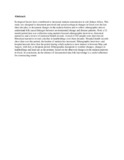| dc.contributor.author | Nyamongo, IK | |
| dc.date.accessioned | 2013-05-28T14:53:44Z | |
| dc.date.available | 2013-05-28T14:53:44Z | |
| dc.date.issued | 2011 | |
| dc.identifier.citation | International Journal of Humanities and Social Science 1, no. 6 (2011): 34-42. | en |
| dc.identifier.uri | http://erepository.uonbi.ac.ke:8080/xmlui/handle/123456789/26624 | |
| dc.description.abstract | Ecological factors have contributed to increased malaria transmission in sub-Sahara Africa. This study was designed to document perceived and actual ecological changes in Gusii over the last three decades; to document changes in the malaria burden and to collect ethnographic data to understand folk causal linkages between environmental change and disease patterns. Over a 12-month period data was collection using malaria focused-ethnographic interviews, historical narratives and a review of statistical health records. A total of 103 people were interviewed. Historical narratives reveal a decline in landholdings over three decades. Hospital health records show that over this period, the burden of malaria has increased. Ethnographic interviews and hospital records show that the period during which malaria is most intense is between May and August, with July as the peak period. Ethnographic data point to weather changes, changes in landholdings and land use as the primary factors in the observed changes in the malaria patterns in Gusii. In conclusion, in the absence of documented data folk knowledge is a useful substitute for constructing trends | en |
| dc.language.iso | en | en |
| dc.subject | Malaria Risk | en |
| dc.subject | Ecological Change in Gusii | en |
| dc.subject | Hospital Data and Community Narratives | en |
| dc.title | Malaria Risk and Ecological Change in Gusii: What Can We Learn from Hospital Data and Community Narratives? | en |
| dc.type | Article | en |

